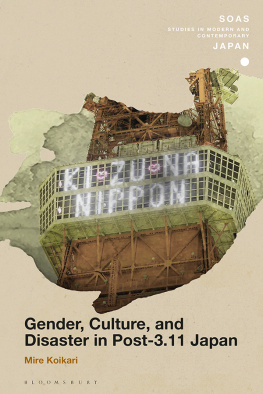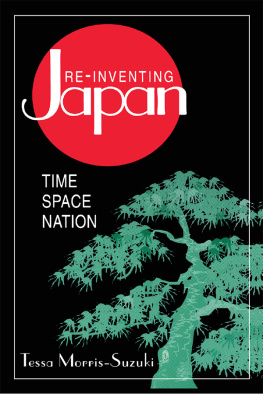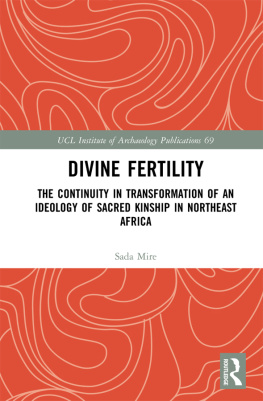Gender, Culture, and Disaster in Post3.11 Japan
SOAS Studies in Modern and Contemporary Japan
SERIES EDITOR:
Christopher Gerteis (SOAS, University of London, UK)
EDITORIAL BOARD:
Stephen Dodd (SOAS, University of London, UK)
Andrew Gerstle (SOAS, University of London, UK)
Janet Hunter (London School of Economics, UK)
Barak Kushner (University of Cambridge, UK)
Helen Macnaughtan (SOAS, University of London, UK)
Aaron W Moore (University of Edinburgh, UK)
Timon Screech (SOAS, University of London, UK)
Naoko Shimazu (NUS-Yale College, Singapore)
Published in association with the Japan Research
Centre at the School of Oriental and African Studies,University of London, UK.
SOAS Studies in Modern and Contemporary Japan features scholarly books on modern and contemporary Japan, showcasing new research monographs as well as translations of scholarship not previously available in English. Its goal is to ensure that current, high quality research on Japan, its history, politics and culture, is made available to an English-speaking audience.
Published:
Women and Democracy in Cold War Japan, Jan Bardsley
Christianity and Imperialism in Modern Japan, Emily Anderson
The China Problem in Postwar Japan, Robert Hoppens
Media, Propaganda and Politics in 20th Century Japan, The Asahi Shimbun Company (translated by Barak Kushner)
Contemporary Sino-Japanese Relations on Screen, Griseldis Kirsch
Debating Otaku in Contemporary Japan, edited by Patrick W. Galbraith, Thiam Huat Kam and Bjrn-Ole Kamm
Politics and Power in 20th-Century Japan, Mikuriya Takashi and Nakamura Takafusa (translated by Timothy S. George)
Japanese Taiwan, edited by Andrew Morris
Japans Postwar Military and Civil Society, Tomoyuki Sasaki
The History of Japanese Psychology, Brian J. McVeigh
Postwar Emigration to South America from Japan and the Ryukyu Islands, Pedro Iacobelli
The Uses of Literature in Modern Japan, Sari Kawana
Post-Fascist Japan, Laura Hein
Mass Media, Consumerism and National Identity in Postwar Japan, Martyn David Smith
Japans Occupation of Java in the Second World War, Ethan Mark
Gathering for Tea in Modern Japan, Taka Oshikiri
Engineering Asia, Hiromi Mizuno, Aaron S. Moore and John DiMoia
Automobility and the City in Japan and Britain, c. 19551990, Simon Gunn and Susan Townsend
The Origins of Modern Japanese Bureaucracy, Yuichiro Shimizu (translated by Amin Ghadimi)
Kenkoku University and the Experience of Pan-Asianism, Yuka Hiruma Kishida
Overcoming Empire in Post-Imperial East Asia, Barak Kushner and Sherzod Muminov
Imperial Japan and Defeat in the Second World War, Peter Wetzler
Gender, Culture, and Disaster in Post-3.11 Japan, Mire Koikari
The idea for this book first emerged in Okinawa in 2013, where I was conducting research on gender and militarization in US-occupied Okinawa (19451972). Retracing the ways in which women and domesticity had been mobilized in the Cold War militarization of Okinawa, I could not help but notice the resurgence of similar dynamics involving gender, home, and the military in post3.1 Japan, whose relentless call for national recovery and refortification was complexly refracted in this former Japanese colony. The question of Cold War and postCold War militarizationcontinuities as well as reconfigurationsfollowed me as I returned to Hawaii, another island community burdened with the legacy of militarism and colonialism that was emerging as an off-shore site for Japans resilience-building. Subsequent trips to Thoku (Fukushima and Miyagi), though brief, provided another vantage point from which to ponder the nature, extent, and implications of cultural formation and transformation proceeding in the post3.11 nation. Situated in the triangulated space linking Okinawa, Thoku, and Hawaii, Japans move toward resilience began to take on the outlook not simply of a national-domestic endeavor but of a transnational project of exceptional reach and dynamism, demanding a multilayered analysis of gender, culture, and disaster. The result is this book, an attempt to critically engage with the premise and promise of resilience-building, whose seemingly incontestable claim to safety and security belies the workings of militarism, neoliberalism, and neoconservatism that undergird the emerging regime. As this book went into production in March 2020, the COVID-19 pandemic enveloped the world, raising the specter of global crisis and precipitating resilience mobilization of an unprecedented scale. Amid the fear and trepidation triggered by the outbreak, we are faced with an even more urgent need to approach the politics of crisis management from critically informed perspectives.
In the course of my research, I benefitted from various exchanges with colleagues and friends in the United States, Japan, and beyond. Karl Ian Cheng Chua and Tom Le were extraordinarily generous in sharing their research insights and helping me think about Japans military and militarization from fresh perspectives. My conversations with Azuma Eiichiro, Iijima Mariko, Gwyn Kirk, Derek Hird, Kuraishi Shino, Nakano Kichi, Wendy Matsumura, Tze May Loo, Martin Dusinberre, Habu Junko, Katja Valaskivi, and the late Romit Dasgupta were invaluable, inspiring new thoughts and illuminating new research directions as I tackled the questions of gender and disaster. In the initial phase of this project, Matsuda Motoji, Matsui Kazuko, and Kawasaki Ichir offered suggestions as well as encouragement, both of which proved vital in the subsequent course of research. Jan Bardsley has always been a wonderful colleague, supporter, and friend, whose generosity I am always in awe of and whose wisdom I always rely on. Victoria Scott and Gwyn Kirk provided editorial assistance with patience as well as precision, improving my prose tremendously.
This project relied on library and archival resources in the United States and Japan. The East Asia Collection at Stanford University in Palo Alto, the Great Hanshin-Awaji Earthquake Disaster Materials Collection at Kbe University in Kbe, and the Disaster Management Library (Bsai Senmon Toshokan) in Tokyo have a wealth of information on gender, culture, and disaster in Japan, and I owe much to staff members at each library in searching for and locating necessary documents. In 2016 and 2017, the Japan Foundation Summer Institute gave me opportunities to engage in a series of discussions on disaster resilience with scholars hailing from the United States, Japan, and Southeast Asia, and to visit disaster-struck communities in Thoku to witness the complex nature of recovery and reconstruction at the grassroots level. The richness of my experience at these two summer institutes had much to do with the hard work done by staff members of the foundation, including Yamamoto Masako, Nishimatsu Hideki, Hayase Tomonori, Christy Bahr Hirokawa, Yoshimura Shhei, Miyazaki Aya, Purwoko Adhi Nugroho, and Nakamichi Tokumi. The funding provided by the Association for Asian Studies Northeast Asia Council, the Stanford University Asian Library Collection, and the University of Hawaii Center for Japanese Studies and Womens Studies enabled my numerous research trips to Japan and North America. Various parts of the project have been presented at the Berkshire Womens History Conference in 2014, the symposium Safety and Security in Japanese Popular Culture after Fukushima at Leiden University in 2015, and the conference Constructing Masculinities in Asia at the University of San Francisco Center for Asia and Pacific Studies in 2016. I learned much from the fellow presenters and participants at these forums.









